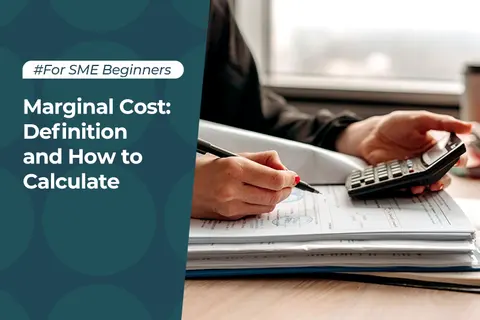Marginal Cost: Definition and How to Calculate

Table of Contents
Marginal cost, a critical metric for companies, quantifies the incremental expenses incurred in producing additional units of goods or services. This figure is derived by dividing the change in costs and quantity, which is pivotal in comprehending the marginal cost formula. This analysis yields manifold advantages, such as enhanced cost efficiencies stemming from heightened production levels, and aids in determining whether price adjustments are warranted to offset any losses incurred.
What does the Marginal Cost Mean?
Marginal cost, a pivotal metric in production economics, signifies the additional expenditure incurred in manufacturing each additional unit of a product. This figure encapsulates both fixed costs for previously produced items and variable costs for forthcoming units. Essentially, marginal cost is the differential cost of producing an extra item, calculated by dividing the change in costs by the change in quantity.
This cost dynamic is integral in analyzing production efficiency and pricing strategies. Should the marginal cost of additional units fall below the unit price, profitability is attainable. Indeed, in many manufacturing contexts, increased output volume correlates with decreased marginal production costs, elucidating the intricate relationship between scale and cost dynamics.
How to Calculate the Marginal Cost?
Prior to delving into the calculation of marginal cost, it is imperative to grasp the nuances of changes in costs and changes in quantity:
-
Fluctuations in Costs
Throughout the production process, expenses may undergo alterations, either escalating or diminishing. Such variations typically coincide with adjustments in output volume demanded by manufacturing exigencies. For instance, if a factory ramps up its production of automobiles, it may incur heightened costs for raw materials and labor, as the wholesale marketplace, thereby exemplifying the impact of changes in costs.
-
Variations in Quantity
The volume of output can fluctuate at different junctures of the production cycle, necessitating a discerning evaluation. Adequate consideration of these variations is essential for assessing consequential shifts in costs. For instance, a bakery experiencing a surge in demand for its pastries must ensure that its production quantities are adequately accounted for to accurately gauge the ramifications on costs.
What is the marginal cost formula?
Marginal cost = Change in costs / Change in quantity
How does marginal cost affect consumer decision-making?
Initially, as an online seller,when the marginal cost of a product remains lower than the corresponding marginal benefit perceived by the consumer, it fosters an escalation in the overall consumption of said product. However, over time, this advantage wanes as the consumer gradually incurs higher expenditures with each successive purchase, thereby diminishing the utility derived from the incremental benefit.
For instance, consider a situation where a coffee aficionado finds that the pleasure gained from savoring an extra cup of their favorite brew exceeds the additional cost incurred. Consequently, they may indulge in multiple cups, enhancing their overall satisfaction. Yet, as they continue to purchase more cups, the joy derived from each subsequent purchase dwindles, reflecting the diminishing marginal utility of the product.
What are the Benefits of the Marginal cost?
The marginal cost of production holds significant importance for businesses, particularly in financial analyses, offering a range of potential benefits:
1. Resource Allocation Optimization
By pinpointing areas where marginal revenue surpasses marginal costs, businesses can strategically concentrate their resources. For example, a software company may allocate more resources to developing a particular feature that yields higher marginal revenue relative to its marginal cost.
2. Cost Evaluation Flexibility
Understanding fluctuations in production costs allows companies to assess the financial implications of scaling production up or down. For instance, a clothing manufacturer can evaluate the cost-effectiveness of producing additional units during peak seasons versus reducing output during slower periods.
3. Efficiency Enhancement
Marginal cost analysis aids in identifying opportunities for improving production efficiency. For instance, a car manufacturer may use this analysis to streamline its manufacturing processes, thereby reducing per-unit production costs and optimizing overall operations.
4. Cost Reduction Potential
Through careful analysis of marginal costs, companies can potentially lower the overall cost of producing a product line. For example, a food processing company may identify inefficiencies in its supply chain, leading to cost-saving measures that reduce the overall production cost of its product line.
5. Pricing Strategy Determination
Marginal cost analysis helps companies decide whether to continue production or adjust prices based on incurred losses. For instance, a software company may assess whether to increase subscription fees if marginal costs exceed marginal revenue, thus ensuring profitability.
What are the Limitations of the Marginal Cost?
In the realms of accounting and economics, the potential advantages derived from marginal costs might seem boundless in theory. However, in practical terms, these benefits must contend with the imperative of managing inventory while navigating the complexities of economies of scale.
1. Economic Realities vs. Theoretical Benefits
While marginal cost analysis offers a theoretical promise of infinite benefits, the pragmatic application necessitates a nuanced approach, considering factors such as economies of scale and inventory management. For instance, a manufacturing company may realize substantial savings by producing additional units up to a certain point, capitalizing on economies of scale. However, beyond this threshold, the costs associated with excess inventory may outweigh the potential benefits, necessitating careful consideration.
2. Product Lifecycle Dynamics
Most products undergo a lifecycle characterized by fluctuations in value over time. Initially, products typically command higher prices and exhibit greater demand, gradually depreciating in value as they approach the end of their lifecycle. For instance, a newly released electronic gadget may fetch a premium price, but its value diminishes as newer models enter the market, such as many affiliate marketing programs, highlighting the importance of strategic inventory management to mitigate losses associated with depreciation.
3. Risk of Overproduction
If a company indiscriminately ramps up production without considering market demand, it risks overproducing goods that exceed the capacity of consumers to purchase. In such cases, the company may be forced to write off excess inventory, incurring substantial losses and compromising overall profitability. For example, a fashion retailer that overestimates demand for a particular clothing line may be left with surplus inventory that must be sold at discounted prices or ultimately written off, eroding profit margins.
Conclusion
The concept of marginal cost, while endowed with notable advantages, also carries inherent drawbacks when applied in economic contexts. It behooves major corporations to meticulously compute their marginal costs and discern optimal strategies tailored to their specific circumstances, adopting a nuanced approach to marginal cost analysis, thereby they can navigate complex economic landscapes and propelling sustainable economic development to foster economic growth and sustainability.
Start your borderless business here
Tell us about your business and stay connected.
Keep up with the latest from Alibaba.com?
Subscribe to us, get free e-commerce tips, inspiration, and resources delivered directly to your inbox.
















